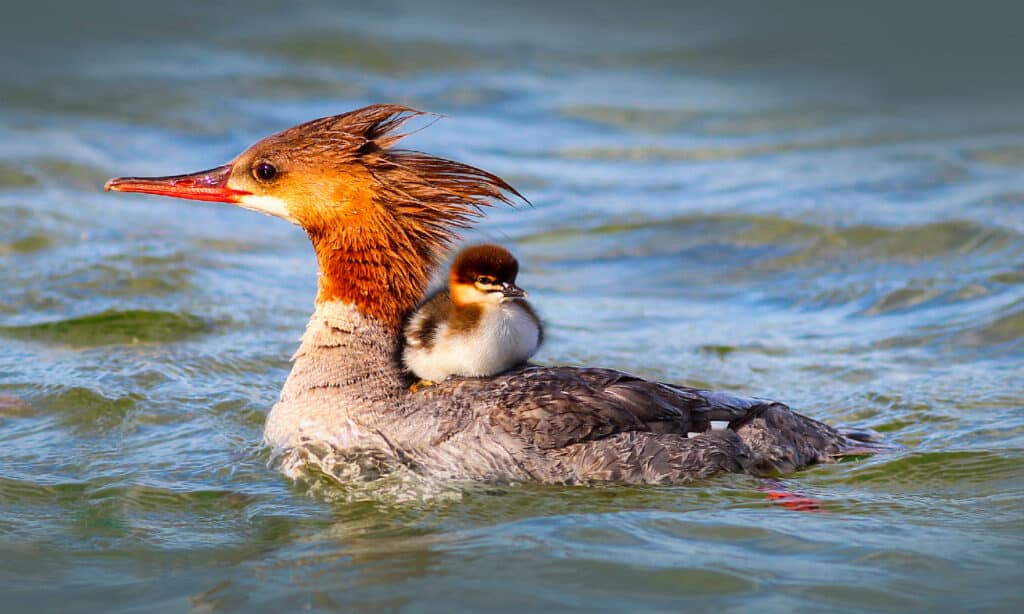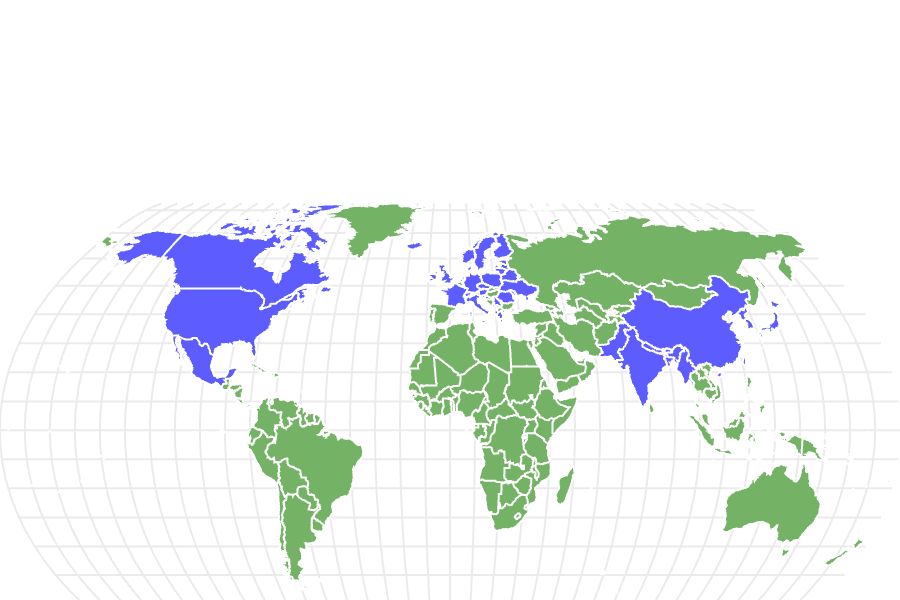Merganser
Mergus Merganser
They line their nests with their feathers
Advertisement
Merganser Scientific Classification
- Kingdom
- Animalia
- Phylum
- Chordata
- Class
- Aves
- Order
- Anseriformes
- Family
- Anatidae
- Genus
- Mergus
- Scientific Name
- Mergus Merganser
Read our Complete Guide to Classification of Animals.
Merganser Conservation Status
Merganser Facts
- Prey
- Fish and aquatic invertebrates
- Main Prey
- Salmon, trout, sculpin, and crustaceans
- Name Of Young
- Ducklings
- Group Behavior
- Social
- Flocks
- Fun Fact
- They line their nests with their feathers
- Estimated Population Size
- 1.7 to 2.4 million
- Biggest Threat
- Wildfires and spring heat waves
- Most Distinctive Feature
- Bushy tufts on the backs of their heads
- Distinctive Feature
- Large white patches on upper wings
- Wingspan
- 34 inches
- Incubation Period
- 30 to 35 days
- Age Of Independence
- 65 to 70 days
- Age Of Fledgling
- 1 day
- Habitat
- Lakes and rivers of forested areas
- Predators
- Red squirrels, black bears, and birds of prey
- Diet
- Carnivore
- Lifestyle
- Diurnal
- Favorite Food
- Salmon and trout
- Type
- Bird
- Common Name
- Merganser
- Special Features
- Narrow, serrated bills used to grab fish
- Number Of Species
- 6
- Location
- North America, Europe, and Asia
- Nesting Location
- Natural tree cavity within one mile of water
- Migratory
- 1
View all of the Merganser images!
“Mergansers are large ducks that nest in hollow trees.”
Summary
The merganser is a long-bodied duck that spends its days afloat in freshwater lakes and rivers. These elegant diving birds have striking iridescent heads and crisp white feathers, making them easy to spot even when they flock with other ducks. They have an extensive range across several continents, giving you plenty of viewing opportunities. Check out the interesting facts about the merganser, including where they live, what they eat, and how they behave.
5 Amazing Merganser Facts
- Mergansers line their nests with their feathers.
- The males abandon the nest during incubation, and the females raise the young.
- Mother mergansers and her young will join groups with other females and young.
- They have serrated bills that can easily grip slippery fish.
- Babies leave the nest one day after hatching.
Where to Find the Common Merganser
The merganser, or goosander, lives in lakes and rivers of forested areas in North America, Europe, and Asia. They inhabit over 40 countries, including the United States, the United Kingdom, China, Switzerland, and Serbia. You can find them in mature forests in spring and summer, with plenty of trees for nests. During winter, they inhabit large lakes, rivers, and reservoirs. They prefer freshwater systems, but you may find them in coastal regions in bays, estuaries, and harbors. You can easily spot them sitting on rocks along rivers during the warmer months in North America. And in winter, you can find them in large flocks with other duck species, typically on a lake.
Merganser Nest
Females build their nests within a mile of water and no more than 100 feet above the ground in a natural cavity or woodpecker hole in a tree. They may also use rock crevices, holes under tree roots, and buildings. She shapes a nest bowl using wood chips, shavings, and grass. Then, she lines it with downy feathers plucked from her breast.
Scientific Name
The merganser (Mergus Merganser) is from the Anseriformes order, comprising over 180 species of waterfowl, and the Anatidae family includes birds such as ducks, geese, and swans. Mergus is the genus of fish-eating ducks, and Merganser is Latin for “goose.”
Size, Appearance, & Behavior

Mother mergansers and her young will join groups with other females and young.
©iStock.com/Anna39
These long-bodied ducks are smaller than a goose but more prominent than a mallard. They have thin, pointed wings and narrow bills, and females have bushy tufts on the backs of their heads. They grow between 21 and 28 inches long and weigh 31 to 76 ounces, with a 34-inch wingspan. Adult males have bright white bodies with black backs, red bills, and dark green, iridescent heads. Females, immatures, and non-breeding males have gray bodies, white chests, and reddish-brown heads. You can see the large white patches on their upper wings when in flight.
During summer, females raise their young while males form flocks. Females and their young will often join groups of other females and young. Mergansers form large communities during the winter to feed and court and may mix with other diving duck species. Their groups can grow to 75 individuals, mainly spending their time floating on water, fishing, and sleeping. Common mergansers have an average speed of 43 Mph.
Migration Pattern and Timing
Mergansers are short to medium-distant migrants. They spend the breeding season throughout much of Canada in North America before heading south into the United States. Some Northeastern and Northwestern United States populations stay in their environments year-round. British breeding birds are almost entirely resident, and those in Northwest Russia winter in the Baltic Sea. During brutal winters, birds in the Baltic move Southwest.
Diet
Mergansers are carnivores who mainly eat fish and aquatic invertebrates.
What Does the Merganser Bird Eat?
Their primary diet is fish, but they will also eat mollusks, insects, worms, crustaceans, frogs, birds, small mammals, and plants. During the winter, they eat a fish-heavy diet, including salmon, trout, sculpin, sunfish, minnows, and eels. During breeding season’s warmer months, they complement their fish diet with flies, dragonflies, water striders, beetles, caterpillars, spiders, snails, and mussels. They forage in less than 13 feet of water by diving underwater and probing the sediment with their long, serrated bills, quickly grasping slippery prey. Their young eat aquatic invertebrates for the first 12 days before switching to fish.
Predators, Threats, and Conservation Status
The IUCN lists the merganser’s population as “least concern.” Their extensive range, large estimated population, and lack of fragmentations exclude them from “threatened” status. But like most creatures on our planet, the merganser is susceptible to the effects of climate change. In the future, wildfires could incinerate their habitats, and spring heat waves could endanger the young in their nests.
What Eats the Merganser?
Common mergansers are one of the top predators in the aquatic food chain, but that doesn’t mean this bird doesn’t have its own predators. The survival rate of merganser young is high, but they may occasionally fall victim to red squirrels, black bears, northern flickers, and martens. Immature mergansers are vulnerable to birds of prey like hawks, eagles, and owls. Predatory fish like northern pike may also take advantage of young or weak birds.
Reproduction, Young, and Molting
Males initiate courtship by quickly swimming in circles near the females, stretching its neck upwards, and giving soft calls. Females will lay anywhere from six to thirteen eggs in their own or another female’s nest. Females build the nest site and incubate the eggs by themselves; males abandon the nest during the incubation process, leaving females to raise the young. Incubation lasts 30 to 35 days, and the young leave the nest no more than one day after hatching. The young can feed themselves, but the mothers still care for them for several weeks. They can fly within 65 to 70 days after hatching. Mergansers reach sexual maturity around two years old and can live up to 13 years old.
Population
The entirety of their population is unknown, but the IUCN estimates their global number between 1.7 to 2.4 million. The European population is estimated at 134,000 to 206,000 mature individuals. Europe’s population is stable, and it has increased slightly over the last 40 years in North America. Due to the Merganser’s massive range, short-term trends and fluctuations are not recorded. Some groups are stable, while others have insignificant increases and decreases.
Up Next:
Sources:
- https://www.iucnredlist.org/species/22680492/132054083
- https://cdnsciencepub.com/doi/abs/10.1139/z85-189
- http://bioweb.uwlax.edu/bio203/2010/bales_aman/interactions.htm
- https://www.jstor.org/stable/1365825
- https://ec.europa.eu/environment/nature/conservation/wildbirds/hunting/docs/reprod_25-31_en.pdf
Merganser FAQs (Frequently Asked Questions)
What is another name for a merganser?
Other names for merganser include goosander, sawbill, or fish duck.
What is the difference between a duck and a merganser?
The merganser has an elongated body and a long, narrow bill with serrated edges.
Is a common merganser rare?
Like its name suggests, common mergansers are rather common. They have an extensive range across several continents and have a significant population size.
Where do mergansers go in the winter?
Mergansers in North America, head to the United States during winter. Those in Northwest Russia winter in the Baltic Sea. During brutal winters, birds in the Baltic move Southwest.
Can mergansers fly?
Yes! While they spend much of their time floating on water, they travel short to medium distances for migration. Many merganser species are fast, strong fliers.
Do mergansers have teeth?
Their long bills contain serrated edges that are tooth-like. They act similar to teeth but are not true teeth.
How big do mergansers get?
They grow between 21 and 28 inches long and weigh 31 to 76 ounces, with a 34-inch wingspan.
Thank you for reading! Have some feedback for us? Contact the AZ Animals editorial team.
Sources
- Red List / BirdLife International, Available here: https://www.iucnredlist.org/species/22680492/132054083
- Canadian Science Publishing / C. C. Wood and C. M. Hand, Available here: https://cdnsciencepub.com/doi/abs/10.1139/z85-189
- The Common Merganser / Amanda Bales, Available here: http://bioweb.uwlax.edu/bio203/2010/bales_aman/interactions.htm
- JSTOR / The Condor / Bertin W. Anderson, Michael G. Reeder and Richard L. Timken, Available here: https://www.jstor.org/stable/1365825
- Reproduction & Prenuptial Migration, Available here: https://ec.europa.eu/environment/nature/conservation/wildbirds/hunting/docs/reprod_25-31_en.pdf
















